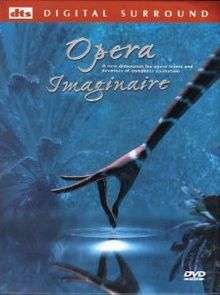Opéra imaginaire
| Opéra imaginaire | |
|---|---|
 DVD cover showing a scene of the "Flower Duet" (from Lakmé) segment | |
| Narrated by | James Smillie |
Production company |
|
Release dates | 1993 |
Running time | 51 minutes |
| Country | France |
| Language | English |
Opéra imaginaire (translates as "an opera for the imagination") is a 1993 French live-action animated musical anthology film, made for television. It has been compared to films like Fantasia[1] and Allegro Non Troppo, and consists of 12 different segments,[2] each one of which is based on a different popular opera, and done in a greater variety of animation styles than Fantasia had done. It was nominated for best production at the CableACE Awards in 1994.
Segments
- Segment's aria: "Vesti la giubba", from Ruggero Leoncavallo's opera Pagliacci, sung by Enrico Caruso (in 1902) in the aria's introduction and Franco Corelli (in 1960) throughout the rest of it. A stop motion animation based on the opera with a dark comedy theme and the characters rendered as circus-style clowns. A "happier" ending is shown with the 2D-animated ghost of Nedda reconciling with a rather obese Canio after he had "accidentally" killed her. Directed by Ken Lidster.
- Segment's aria: "La donna è mobile", from Giuseppe Verdi's opera Rigoletto, sung by Nicolai Gedda. In the crimson heart of the wine in his glass, the (live-acted) Duke of Mantua from the opera embarks on a 2D fantasy in which he sees hand-drawn animated nude women based on those who come from famous paintings by French painters. Directed by Monique Renault.
- Segment's aria: "Avec la garde montante", from Georges Bizet's opera Carmen, sung by Les Petits Chanteurs à la Croix de Bois with the Opéra National de Paris, conducted by Rafael Frühbeck de Burgos in 1970. Carmen (live-acted) lays down her tarot cards which through CGI spring to life with the images the cards each depicting one of her choices from the opera: Don José, Escamillo, or Death. Directed by Pascal Roulin and Christophe Vallaux.
- Segment's aria: "Voi che sapete", from Wolfgang Amadeus Mozart's opera The Marriage of Figaro, sung by Susanne Danco. A tribute to Cherubino's cross-dressing adventures, rendered through paper cut-out style animation against CGI backgrounds. Directed by Pascal Roulin.
- Segment's aria: "Un bel dì vedremo", from Giacomo Puccini's opera Madame Butterfly, sung by Felicia Weathers. The story of Cio-Cio-San's tragedy is rendered through animation in the style of traditional Japanese watercolors. Directed by Jonathan Hills.
- Segment's aria: "Au fond du temple saint", from Georges Bizet's opera Les pêcheurs de perles, sung by Nicolai Gedda and Ernest Blanc. A wispy, black-and-white, rotoscoped animation depicting a condensed version of the opera's plot to its famous aria. Directed by Jimmy T. Murakami.
- Segment's aria: "Bald prangt, den Morgen zu verkünden ... Du also bist mein Bräutigam", from Wolfgang Amadeus Mozart's opera The Magic Flute, sung by Lucia Popp. A 2D CGI animated, geometrical version of the scene of Pamina's attempt at suicide and its prevention, with all the characters' bodies rendered in geometrical shapes on an ever shifting stage. Directed by Raimund Krumme.
- Segment's aria: "Questo è un nodo avviluppato", from Gioachino Rossini's opera La Cenerentola, sung by Giulietta Simionato, Ugo Benelli, Sesto Bruscantini, Dora Carra, Miti Truccato Pace, and Paolo Montarsolo with the Orchestra of the Maggio Musicale Fiorentino, conducted by Oliviero De Fabritiis in 1963. A sunny take on the opera and the Cinderella fairy tale through hand-drawn animation with the characters randomly turning into each other, as well as characters from other fairy tales, including "Goldilocks and the Three Bears", "Little Red Riding Hood", and "The Three Little Pigs". Directed by Stephen Palmer.
- Segment's aria: "Le veau d'or", from Charles Gounod's opera Faust, sung by Nicolai Ghiaurov. A hand-drawn, sketchy rendition of the ill-fated romance between Faust and Marguerite as the booming voice of Mephistopheles, who manipulates them like puppets, sings throughout the sequence. Directed by Hilary Audus.
- Segment's aria: "Noi siamo zingarelle", from Giuseppe Verdi's opera La traviata, sung by the Chorus of the Accademia Nazionale di Santa Cecilia of Rome, conducted by Francesco Molinari-Pradelli. An unrelated visual version of the opera with stop motion claymation sweets attempting to bring color to a world made of white cake. Directed by Guionne Leroy.
- Segment's aria: "Flower Duet", from Léo Delibes's opera Lakmé, sung by Mady Mesplé and Danielle Millet with the Orchestre du Theatre National de l'Opéra Comique, conducted by Alain Lombard. A rendition of the opera in which Lakmé's arms and hands, through CGI, turn into various flora and fauna of the Indian jungles, including a tree, a cobra, a deer, a bird, a leopard, a woman's arm with bracelets, a rock, a human, a boat, a clump of reeds, and others, as Gerald (live-acted) meets Lakmé (live-acted) in the temple. Directed by Pascal Roulin.
- Segment's aria: "E lucevan le stelle", from Giacomo Puccini's opera Tosca, sung by Carlo Bergonzi. An eerie hand-drawn animation depicting Cavaradossi's final hours of life observed by the angel of death. Directed by José Abel.
Cast
- Ana Lucia Alves as Carmen
- Sébastien Chollet as Zurga
- Franco Corelli as Canio
- Alain de Greffe as Gerald
- Mehdi Manglunki as Nadir
- Bernard Marbaix as the Duke of Mantua
- Fundji Ngelessy as Lakmé
- Rubina Owadally as Leila
- James Smillie as Narrator
References
- ↑ "Opéra imaginaire". The New York Times. Retrieved 25 June 2014.
- ↑ "Opéra Imaginaire" (in French). Planete-jeunesse.com. Retrieved 25 June 2014.
External links
This article is issued from Wikipedia - version of the 9/28/2016. The text is available under the Creative Commons Attribution/Share Alike but additional terms may apply for the media files.